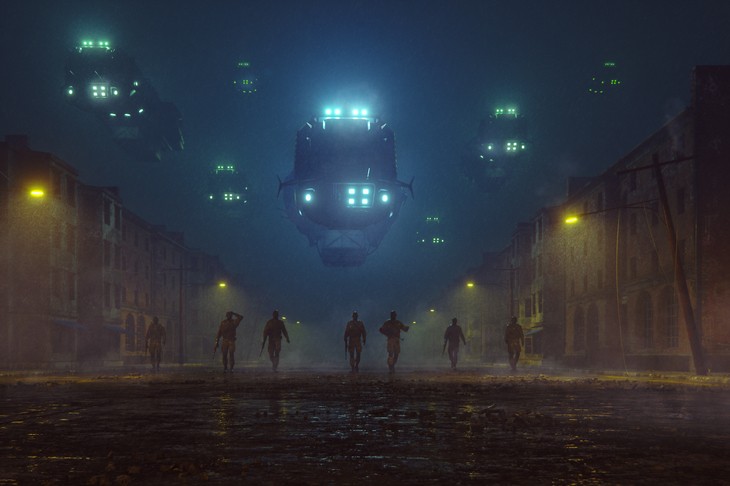Imagine Peace. These were the words that appeared on an otherwise blank page in the New York Times on New Year’s Day 2013. They were paid for by Yoko Ono and they are of course an echo of John Lennon’s most famous song. A few days later, the Guardian conducted an opinion poll in which it asked its readers whether they thought the advert would produce world peace. Surprisingly, a third of the respondents thought that it would, though there was little evidence around the world to confirm them in that hope. By then, the civil war in Syria had already claimed the lives of nearly 200,000 people. It’s now about 400,000.
Wouldn’t it be marvellous if war were just an idea, a very bad one, and that universal peace could be achieved by just imagining it? Jeremy Corbyn is certainly in the Yoko Ono camp. He doesn’t believe that it is worth fighting a war for anything. It is not quite clear where Diane Abbott stands, though she insisted last week that the only war that could be justified would be one like the second world war — the good war, as Americans like to call it. But that is precisely the war we are not going to get. The next world war will not involve great ideological principles any more than it will see mass attacks on multiple fronts and heroic set-piece battles like Stalingrad. But that won’t stop it from breaking out. War is evolving all the time, thanks in part to technology. A crude Darwinian principle appears to be at work which suggests that it will end only when it finally exhausts its evolutionary possibilities.
It is those possibilities that the Great Powers insist on both exploring and exploiting. We can see this in Syria now with Russia and America using proxy forces to confront each other. But we now have theatres of war that were not available during the Cold War. War is being rebooted for a new century and cyber warriors are at the forefront of the endeavour. One writer, Lucas Kello, tells us that the old divisions of peace and war have been consigned to the dustbin of history and we are now living in an era of ‘unpeace’ which could last some time. Two other experts, Google’s Eric Schmidt and Jared Cohen, tell us that we are already fighting a Code War, a non-kinetic struggle in which computers are hacked into, economies sabotaged and secrets stolen on an industrial scale. Or if you want a good idea of what an actual shooting war between the US and China might look like, read Peter Singer and August Cole’s novel Ghost Fleet, in which young cyber-hackers from Silicon Valley answer the call and hack into Chinese computers, and the US discovers on the first day that enemy viruses have gone undetected for years and overnight their planes’ missile-avoidance systems have become missile–attraction ones.
Surely, you may ask, the nuclear taboo will always deter the great powers from engaging in a direct confrontation? It would be reassuring to think so, but nuclear weapons are being upgraded and modernised. We are entering what some in the military call the second nuclear age. What the West finds particularly disturbing is that the Russian military has changed its doctrine to include nuclear weapons in conventional operations. The nuclear taboo may be weakening. In the Crimea crisis, some Russian generals suggested launching an intercontinental missile into Ukraine but replacing its nuclear warhead with a conventional one — just to send a message. Were the US to go to war against North Korea, Pyongyang could send a message, too, by exploding a small nuclear device over the skies of a Japanese city.
We are encouraged these days by materialists to think of our minds as computers that absorb and process information and then get our bodies to perform the output. But the mind also creates and imagines, and we imagine unreal fears and insults that are a threat to our reputations. We behave unpredictably as a result. War continues to feed off the same factors and raw emotions that it always has.
If we want to be a little more scientific in our approach, we might ask, as the Nobel prize-winning ethologist Nikolaas Tinbergen did: what are the origins of war? There is a lot of evidence to suggest that other hominid species were fighting each other long before we came on the scene. They probably did so for the same reasons that we do now: to defend territory. At some point we decided fighting back was cheaper than running away. We still find ourselves contesting territory, whether in Ukraine or the South China Sea. These days, we don’t have to send in mass armies: we can use paramilitaries, mercenaries and mafia mobsters and call it hybrid warfare.
In fact the enemies we have been fighting since 9/11 take a variety of forms and are constantly shape-shifting. Governments have responded by playing their ace card: technology. How do we organise manhunts, asked Donald Rumsfeld at the beginning of the War on Terror. As it happens, drones are the ideal weapon for manhunting, an operation that now has its own technocratic jargon derived in part from social network analysis and what war nerds call ‘nexus topography’, a science of sorts which enables us to map the social environment that binds individuals together and thus to identify and take out the critical nodes, such as terrorist cells.
In the US, the Defense Advanced Research Projects Agency (DARPA) plans to improve the performance of its pilots by investing in machine-learning and artificial intelligence. Soldiers and pilots will partner autonomous or semi-autonomous machines that will one day be able to take their own decisions as to whom to target. Drone pilots already have their brainwaves and heart rhythms constantly monitored to check that they are paying attention and not getting too stressed out. We are becoming increasingly machine-readable in all walks of life.
Tinbergen also encouraged us to ask another question: what are the mechanisms that allow a particular human practice to flourish? One of the most important is literature, which has furnished us over the centuries with inspiring role models which encourage young men to join up. In 2009 passages from the Iliad were read out to West Point cadets who were about to go off to Afghanistan. Stories help us bond with others: at Princeton, experiments have found that through neural coupling the same parts of the brain are energised in both the narrator and his audience.
These days most young men spend their time playing computer games but the digital is merely the next stage in our evolutionary road map. Some of the results in game playing are particularly telling. In 2005, the game World of Warcraft got a new character: a winged serpent whose bite infected players with the plague. Some deliberately got themselves bitten so they could travel back to the enemy state and spark off an epidemic. In no time at all, members of the Department of Homeland Security turned up to discover what motivated young patriotic Americans to become suicide warriors. So it was not that surprising that a few years later Isis began encouraging nine-year-olds to play at terrorism through a game modelled on Grand Theft Auto V. The first British jihadist to blow himself up in Iraq left a message saying that he had gone off to play Call of Duty for real.
Computer gaming has in fact become a vital mechanism in keeping war alive in the imagination. The US Defense Department now reproduces some of the technology seen in computer games and Hollywood blockbusters for lethal use. The Talos suit from the Iron Man franchise is nearing development.
In the past 20 years, war has evolved faster than perhaps ever before. It has opened up two new dimensions in which it can be conducted: space and cyberspace. Terrorists make common cause with each other through the internet. The Chinese opened space up to war in 2007 when they shot down one of their own satellites. Given that we are so dependent on space for everything from inventory accounting to cellphone use, the prospect of a space war is truly alarming. One way the Russians might retaliate after another western mission in Syria is to take out a western satellite by jamming or spoofing. Not that we want to give them any more ideas.
War has increased its cast list, too. Take the empowerment of women. It is no coincidence that many of the most popular warriors on screen are not men. Think of Katniss from the Hunger Games. Indeed, as war continues to evolve, women may be found to be better than men at dealing with its mental challenges. A recent study found they outperform men in inductive reasoning and are better at keeping track of a fast-moving situation.
The real game-changer is going to be AI. Last year, the Pentagon launched Project Maven, which uses data, lots of it, to analyse insurgent attacks. From the time a bomb goes off in a street market, you can rewind history to find its point of origin. At the Santa Fe Institute they have algorithms that can work out how a city works by collecting data on tax returns, gas station revenues and crime statistics. But if this tells you how a city works, it could also help you to shut it down.
Then there are robots. More than 5,000 saw service in Iraq at the height of the military operation. At the moment, they are slow and pretty dumb but fast evolving. The Campaign to Stop Killer Robots fears the day when they will be able to decide who, when and where to target without human instruction. Others believe robots will offer us what Google’s Ray Kurzweil calls a moral upgrade. For some years the US has tried to programme a conscience into the next generation of robots so they won’t suffer from racial or political prejudices. Nor will they know fear or be enraged by the death of friends. It would be safe to surrender to them. A group of Iraqi soldiers actually did surrender to an unarmed robot vehicle in the closing hours of the first Gulf war; the event was captured on CNN.
But programming a robot with a conscience will depend on who is doing the programming: you or the Russians. And that brings us to the main challenge of AI. Machine intelligence doesn’t have to be superior to our own to be dangerous. In the absence of embodied intelligence it may be quite dumb. The real danger may lie in outsourcing more and more key decisions to machines not nearly as intelligent as ourselves.
Even if we do manage to avoid a third world war, we are likely to still find ourselves engaged in a cognitive arms race with actors both familiar and unfamiliar. Imagining peace is not going to save us. War is not an idea: it is part of the human story and we do it very well.


















